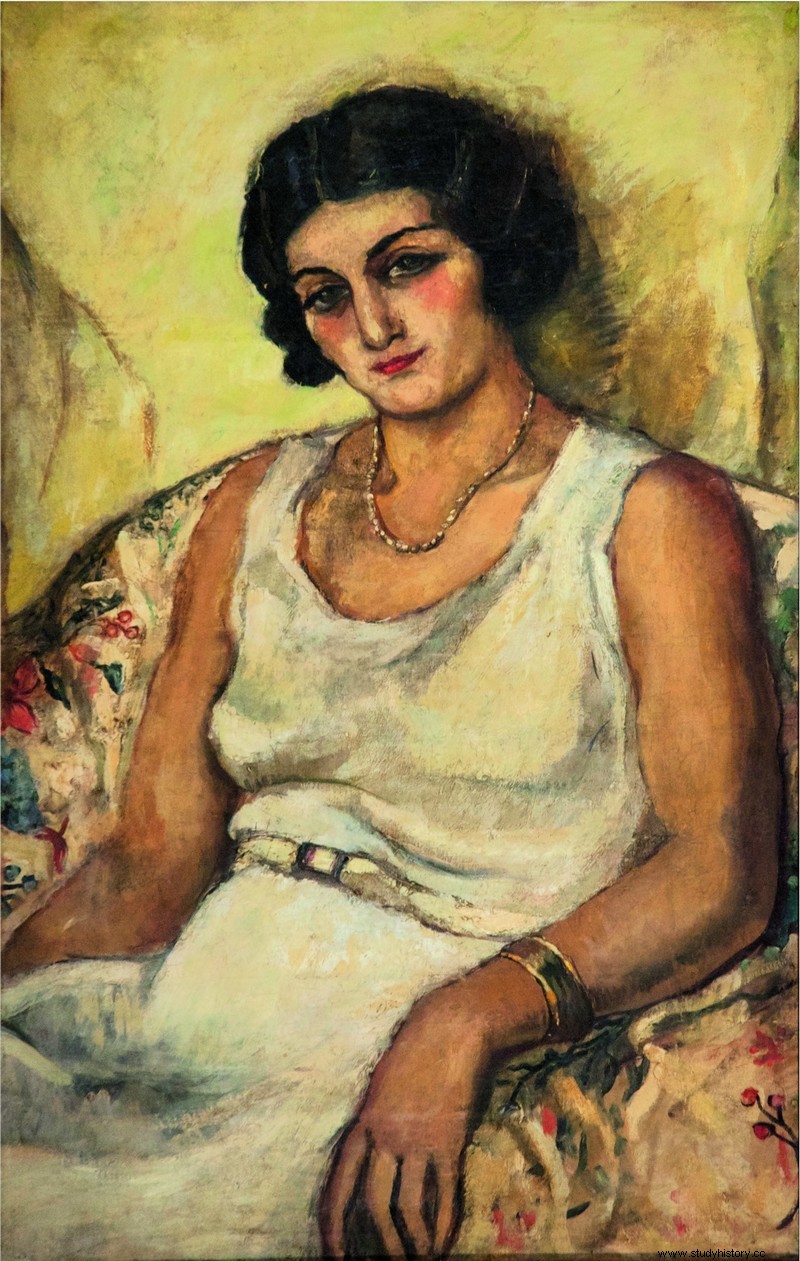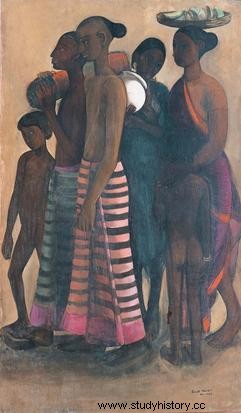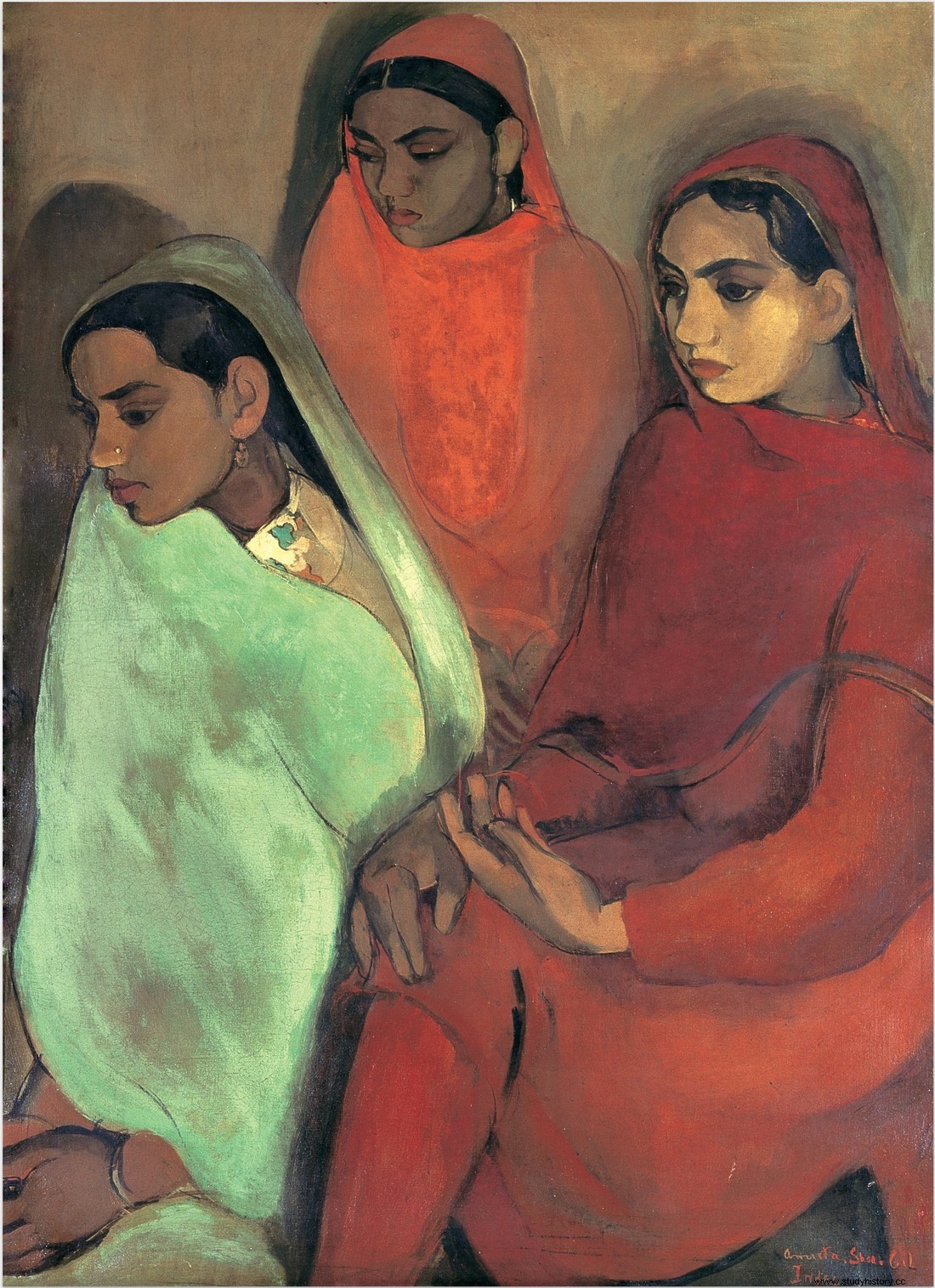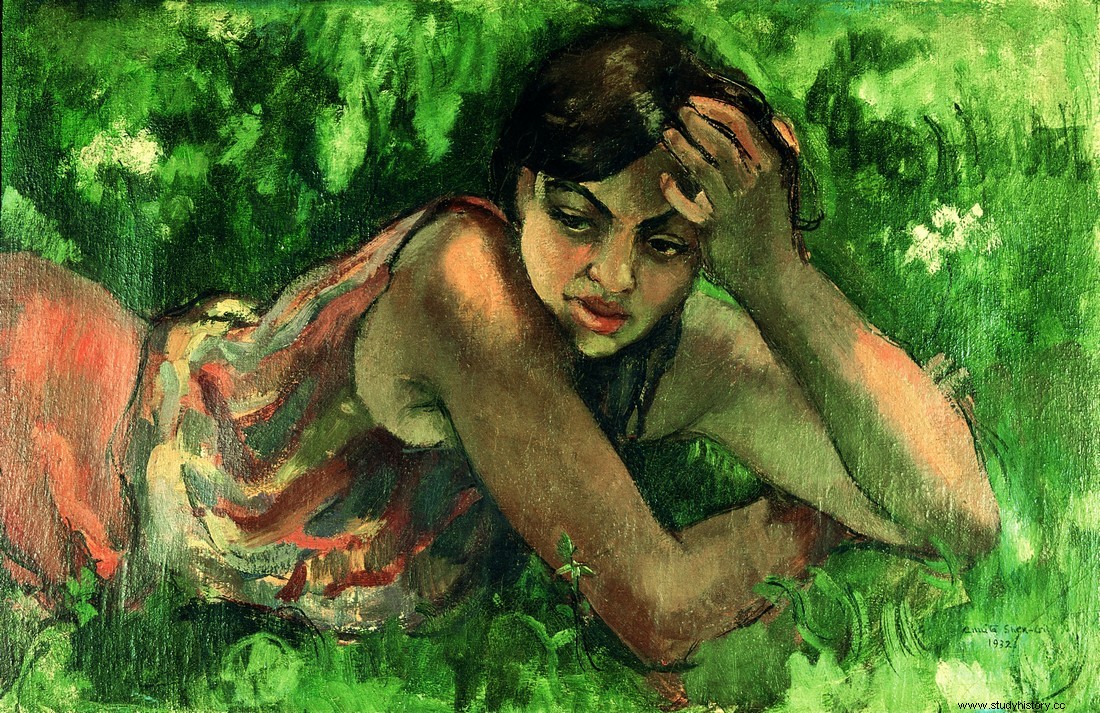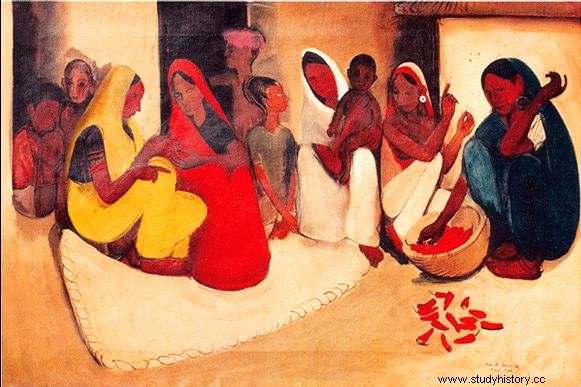Indian and Hungarian painter, Amrita Sher-Gil (1913 – 1941) mixed European influences and Indian artistic traditions in her art. Despite her short career, she left a substantial body of work and influenced generations of artists.
The passion for drawing
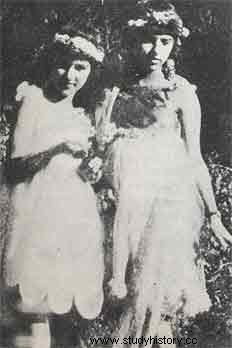
Daughter of Marie-Antoinette Gottesmann, Hungarian Jewish opera singer and Umrao Singh Sher-Gil Majithia, Sikh aristocrat, Amrita Sher-Gil was born on January 30, 1913 in Budapest (Hungary) into a wealthy family. The following year, her parents had another daughter, Indira.
Amrita spent her early childhood in Budapest, where she began to draw and then paint at a very young age. She is particularly attached to painting and drawing the servants of the household, whom she asks to pose for her. While she was painting, her father, fascinated by photography, was introduced to this still uncommon art and documented family life with pictures of his wife and children.
Return to India
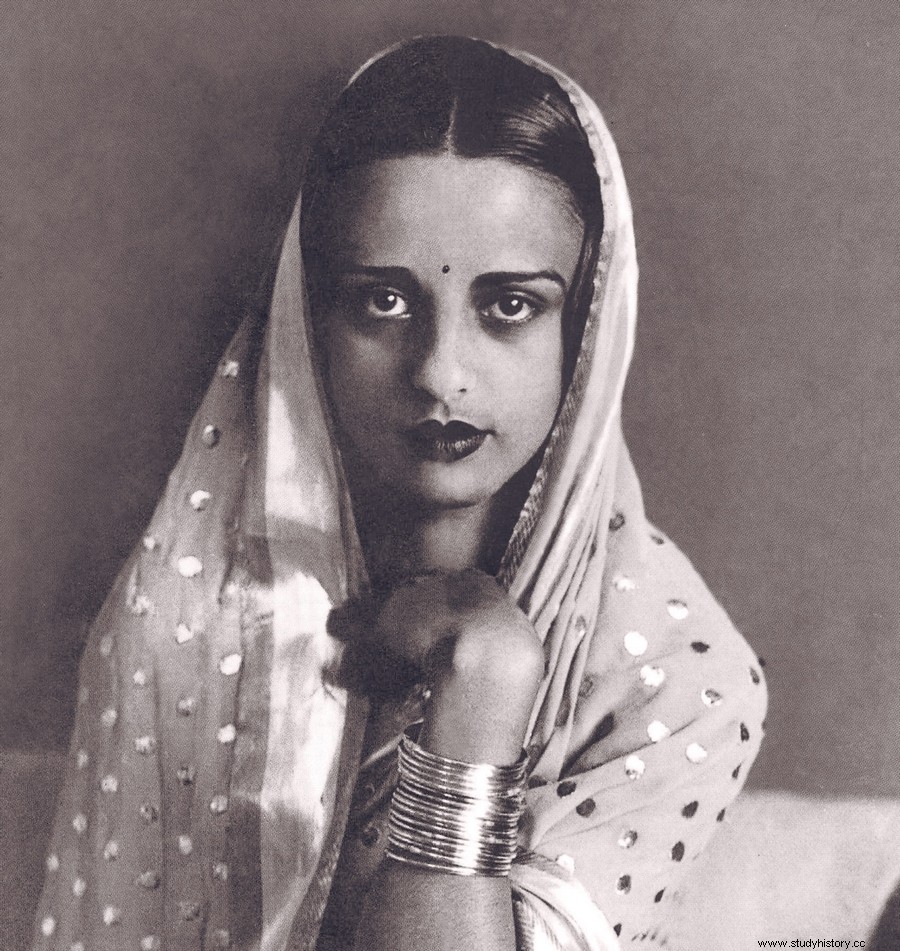 In 1921, Amrita's family, in financial difficulties, moved to India and settled near Shimla, in the north of the country. Aged 8, Amrita, who has been drawing for years, takes her first painting lessons. She and her sister also learn music and take up piano and violin. Very quickly, the two girls began to perform in concert and play in plays at the Gaiety Theater of Shimla.
In 1921, Amrita's family, in financial difficulties, moved to India and settled near Shimla, in the north of the country. Aged 8, Amrita, who has been drawing for years, takes her first painting lessons. She and her sister also learn music and take up piano and violin. Very quickly, the two girls began to perform in concert and play in plays at the Gaiety Theater of Shimla.
From childhood, Amrita showed determination and an assertive character; she is thus excluded from a religious school for declaring herself an atheist. In 1924, she accompanied her mother for a few months in Italy; in Florence, she took art classes and discovered the works of Italian artists before returning to India.
The hatching of an artist
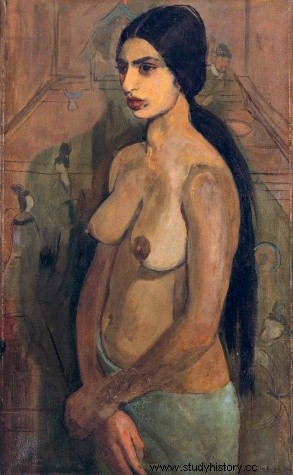 At the age of 16, Amrita Sher-Gil left on a trip with her mother to Europe, and s moved to Paris where she continued her training as a painter, at the Académie de la Grande Chaumière, then at the École des Beaux-Arts. In Paris, she explores her dual Indian and European identity through her clothing and through the inspirations of her art.
At the age of 16, Amrita Sher-Gil left on a trip with her mother to Europe, and s moved to Paris where she continued her training as a painter, at the Académie de la Grande Chaumière, then at the École des Beaux-Arts. In Paris, she explores her dual Indian and European identity through her clothing and through the inspirations of her art.
First fascinated by Gauguin, as revealed by her Self-portrait as a Tahitian , she is also interested in the style of Cézanne, Renoir and Modigliani. His first paintings, mainly portraits, bear this Western influence.
In Paris, Amrita experiences the freedoms of bohemian life. In particular, she will have many adventures, with both men and women. She was briefly engaged to Yusuf Ali Khan, but was rumored to be having an affair and the two did not marry.
European career
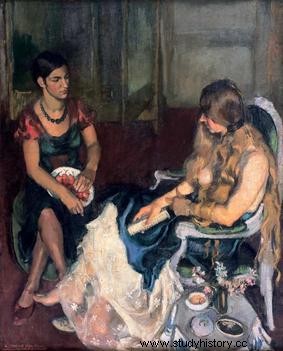 Amrita Sher-Gil's early career was marked by European and Parisian influences. In 1932, his painting Young Girls earned him critical acclaim as well as several awards. At the time, she mainly produced portraits and self-portraits, scenes of Parisian life as well as studies of nudes and still lifes.
Amrita Sher-Gil's early career was marked by European and Parisian influences. In 1932, his painting Young Girls earned him critical acclaim as well as several awards. At the time, she mainly produced portraits and self-portraits, scenes of Parisian life as well as studies of nudes and still lifes.
Questioning her identity, her roots and her culture, Amrita decided to return to live in India in 1934. She wrote to a friend:“I can only paint in India. Europe belongs to Picasso, Matisse, Braque…. India belongs only to me” (I can only paint in India. Europe belongs to Picasso, Matisse, Braque… India belongs to me ). Returning to Shimla, she embarked on a vast enterprise of rediscovering the traditions of Indian art, which she continued until her death.
Indian career
Amrita Sher-Gil travels and embarks on the study of Indian artistic cultures, particularly fascinated by Pahari painting, dating back to the 17 th century, for Mughal painting, or for the frescoes of the Ajanta caves, dating from the 2 th century BC to VIII th century. This search for his roots and these new influences are reflected in his art.
Amrita's paintings now focus on depicting life in India, without pretense and with empathy, representing traditional scenes of life such as the toilet of a young bride or scenes of misery and poverty. After his visit to the Ajanta caves, his style is closer to a classic Indian style, his colors are more lively and luminous and his characters darker.
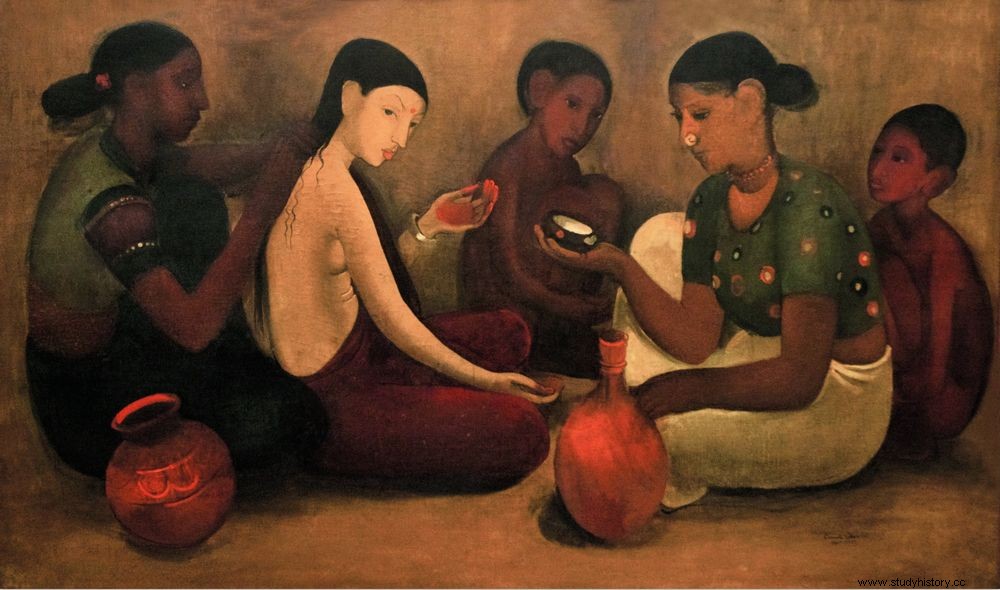
A sympathizer of the Indian National Congress, Amrita is drawn to Gandhi's philosophy and lifestyle. For a time, she also maintains a correspondence with Nehru, impressed by her talent.
A premature death
At 25, Amrita Sher-Gil married a Hungarian cousin, Victor Egan, who moved with her to her parents' home in Shimla. A doctor, Victor had helped her to have an abortion on two occasions before their marriage. In 1941 the couple moved to Lahore where Amrita continued to paint.
In December, at the age of 28 and a few days before the opening of his first major exhibition in Lahore, Amrita contracts a sudden illness and falls into a coma. She died a few days later, leaving, despite her young age, a substantial body of work. The causes of his death are not identified:it could be due to the consequences of an abortion; Amrita's mother, meanwhile, suspected her husband of having murdered her.
Amrita Sher-Gil's art has influenced generations of Indian artists. His work remains so important to Indian heritage that the government is working to preserve his paintings in the country.
